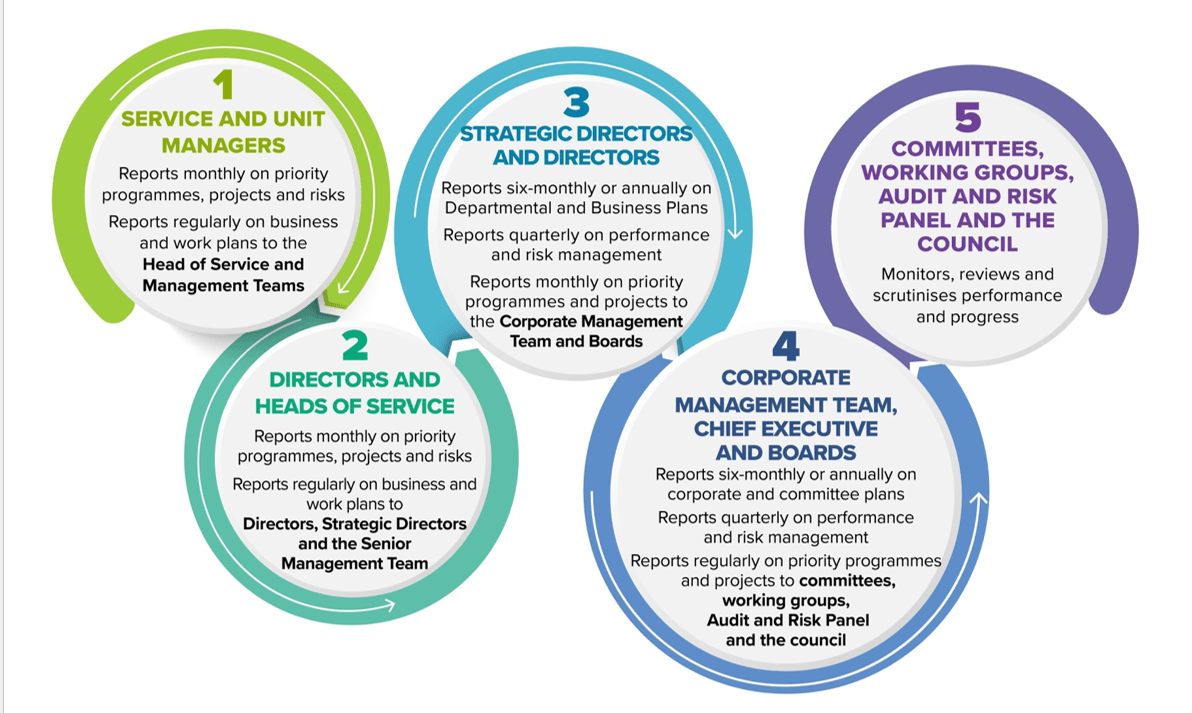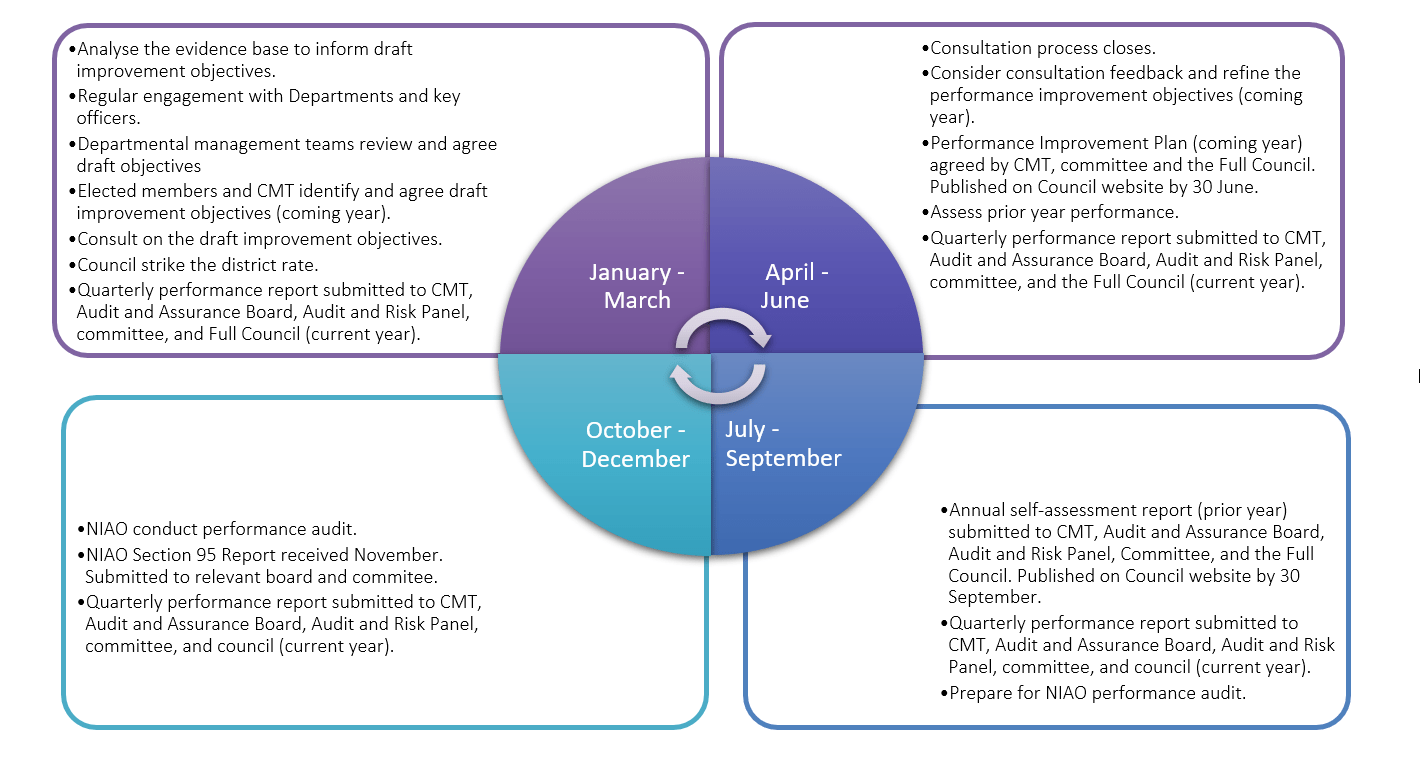Performance monitoring and reporting arrangements
To ensure that we continuously improve and meet the needs and outcomes of our city and residents, we have established governance arrangements in relation to corporate performance management, summarised and set out in figure 5.
Governance arrangements
Monitoring and regular reporting of performance is essential to ensure that priorities are being achieved, and that the information that was collected informed decision-making and plans.
Progress is monitored and reported on a quarterly basis to the Corporate Management Team (CMT), on a quarterly basis to the Audit Assurance Board and the Audit and Risk Panel, and regularly to relevant working groups, relevant committees, and the full council. At year end, corporate performance is assessed using the performance status and trend key in figure 5.
Performance status and trend key
Key to actions or milestones
- red means action or milestone is not achieved
- yellow means action or milestone is partially achieved
- green means an action or milestone is achieved or completed
Key to performance indicator targets
- red means performance indicator target is adrift by 5 per cent or more
- yellow means performance indicator target is adrift by 5 per cent or more
- green means performance indicator target is on target or exceeded target within 1 per cent or better
Key to performance indicator trends
- red arrow pointing downwards means a negative change
- yellow arrow pointing left and right means no significant change
- green arrow pointing upwards means a positive change
Corporate, committee and departmental business plans and strategies containing statutory or self-imposed performance indicators, are monitored, and reported both internally to departmental and the Corporate Management Team and formally to the relevant committee.
In addition, action plans and programme plans relating to the council’s key priority projects are monitored and reported through cross-departmental groups, management teams and boards, and regularly to the relevant committee.
Figure 6 summarises the high-level governance arrangements and departmental and management responsibilities for implementing these.
Each year, we publish a self-assessment report, setting out details of how we have performed as a council and benchmarked against other local authorities where possible. The council is a member of the Association of Public Sector Excellence (APSE), which is a public sector benchmarking organisation. This enables us to compare and improve our performance across a range of services and activities, with other comparable councils.
The council’s internal audit team regularly review the improvement framework, and this is reported to the Audit and Risk Panel. Annually the NIAO reviews the processes and arrangements as part of the annual performance improvement audit and publicly publishes this.
A new planning and performance management framework is currently being developed which will refresh the current arrangements, provide a co-ordinated focus and a robust framework to enhance our continuous improvement journey. This new framework will enable us to deliver our collective responsibility with community planning partners, as well as supporting us to carry out our statutory duty to improve, deliver best value and achieve the best possible impact for the people of Belfast.
Departmental and management responsibilities for implementing the council's governance arrangements
Service and Unit Managers
- Report monthly on priority programmes, projects, and risks
- Report regularly on business and work plans to the Head of Service and management teams
Directors and Heads of Service
- Report monthly on priority programmes, projects, and risks
- Report regularly on business and work plans to Directors, Strategic Directors, and the Senior Management Team
Strategic Directors and Directors
- Report six-monthly or annually on departmental and business plans
- Report quarterly on performance and risk management
- Report monthly on priority programmes and projects to the Corporate Management Team and Boards
Corporate Management Team, Chief Executive and Boards
- Report six-monthly or annually on corporate and committee plans
- Report quarterly on performance and risk management
- Report regularly on priority programmes and projects to committees, working groups, Audit and Risk Panel and the council
Committees, working groups, Audit and Risk Panel and the council
- Monitor, review and scrutinise performance and progress

Annual performance management and improvement cycle
Every year, we review and update our performance improvement objectives and plan to ensure we are continuously improving. Our annual process to develop, monitor, report and review the council’s progress to deliver performance improvement is set out in figure 7.
The council's annual process to develop, monitor, report and review progress
Figure 7 shows twelve months of the year in quarters:
- January to March
- April to June
- July to September
- October to December
Annual performance management and improvement process between January and March
- Analyse the evidence base to inform draft improvement objectives.
- Regular engagement with departments and key officers.
- Departmental management teams review and agree draft objectives.
- Elected members and CMT identify and agree draft improvement objectives (coming year).
- Consult on the draft improvement objectives.
- The council strikes the district rate.
- Quarterly performance report submitted to CMT, Audit and Assurance Board, Audit and Risk Panel, committee, and full council (current year).
Annual performance management and improvement process between April and June
- Consultation process closes.
- Consider consultation feedback and refine the performance improvement objectives (coming year).
- Performance Improvement Plan (coming year) agreed by CMT, committee and the Full Council. Published online by 30 June.
- Assess prior year performance.
- Quarterly performance report submitted to CMT, Audit and Assurance Board, Audit and Risk Panel, committee, and the full council (current year).
Annual performance management and improvement process between July and September
- Annual self-assessment report (prior year) submitted to CMT, Audit and Assurance Board, Audit and Risk Panel, Committee, and the full council. Published online by 30 September.
- Quarterly performance report submitted to CMT, Audit and Assurance Board, Audit and Risk Panel, committee, and the council (current year).
- Prepare for NIAO performance audit.
Annual performance management and improvement process between October and December
- NIAO conduct performance audit.
- NIAO Section 95 Report received November. Submitted to relevant board and committee.
- Quarterly performance report submitted to CMT, Audit and Assurance Board, Audit and Risk Panel, committee, and the council (current year).

